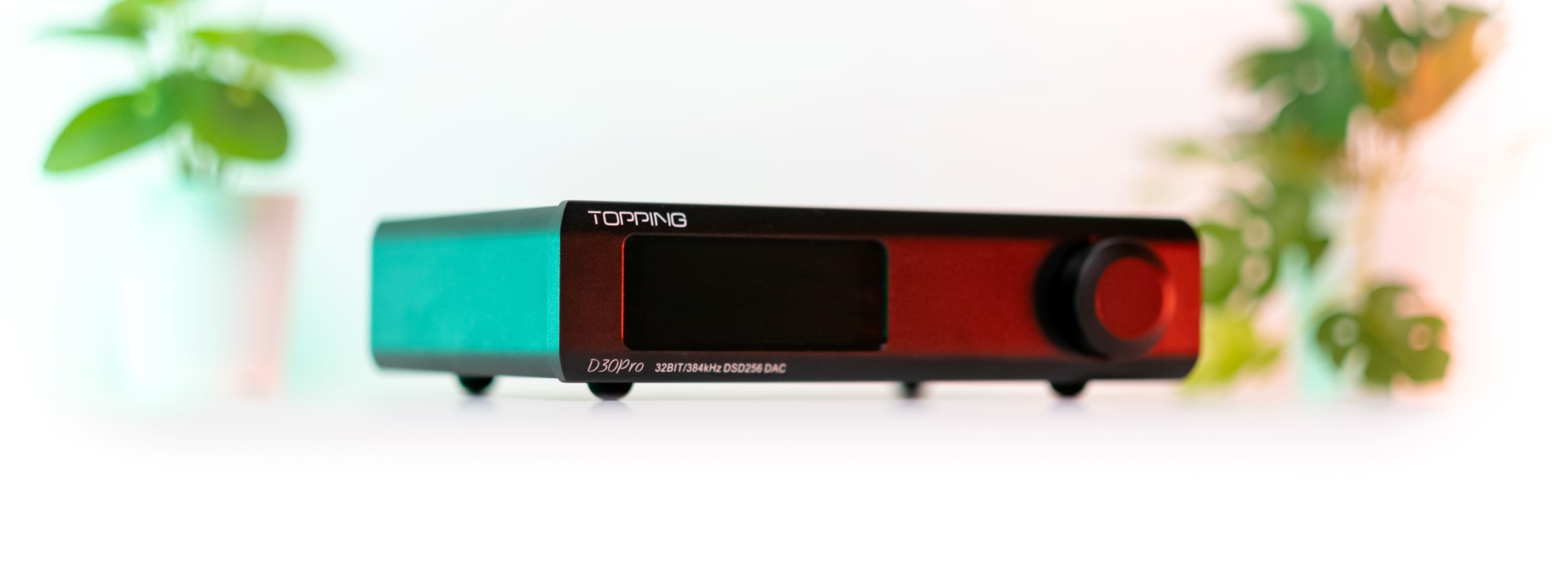
My Video Review:
Alright folks, I might not get too excited seeing another AKM or ESS Sabre based DAC been released in such a crowded landscape that digital audio has become, I’ve covered plenty of those already…but how about some fresh new Cirrus Logic based DACs? I don’t remember listening to such digital creatures for quite a while. There’s a sneaky hard working DAC maker from China that always pushes the envelope when it comes to affordable high-performance converters. There is something that always drags my attention to Topping and to their affordable stuff. Maybe it’s their shape and nice build quality, maybe their no-BS approach to marketing, maybe their straightforward user manuals, their price points, their immaculate measurements or maybe all of the above makes them truly desirable and easy to recommend. Their converters are still having one of the biggest values and those made the biggest splashes lately in the affordable Hi-Fi world. Without Topping we probably wouldn’t have such a fierce competition and we would still think that paying more than $1K is crucial for nicer sonics. There’s a reason I’ve compared their D70S and D90 with much pricier converts and that should tell you a lot how I feel about them.
In recent years, Topping fully upgraded their arsenal with fresh new devices ranging from peanuts money Hi-Fi (D10S) to affordable (D50S) and then to high-performance audio (D90 / D70S). Everything, expect for the D30 line was updated with brand new electronics and that is a norm nowadays if you want to be relevant. Their aging D30 was using a very loved chip (CS4398) that is still being used today, even in high-end electronics. The biggest issue, is that I find it outdated compared to the newest silicon. Its dynamic range, noise rejection and limited sample rates aren’t impressive anymore and that is why Cirrus Logic closed their doors, coming back with a modern silicon that can stand its ground compared to its competition. Topping saw a small window of opportunity and from an entry-level D30, they shaped a much higher one, something that Topping never did in their lifetime: a quad-mono converter by the name of D30 PRO. The PRO moniker suits it perfectly, since it looks like a much higher tiered device, but as usual, I’ll be approaching it as a critic and also as a music lover, commenting on everything I find useful to share with you.
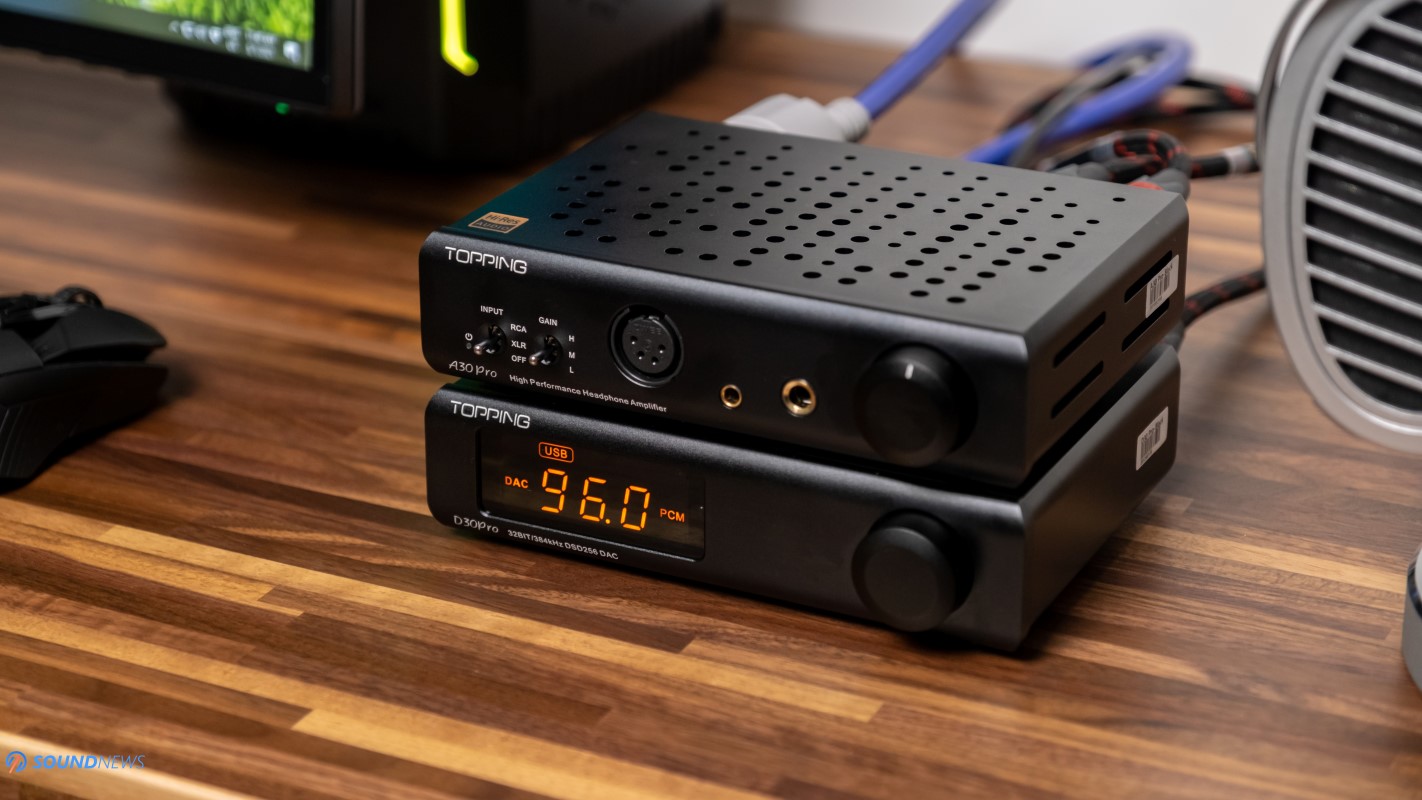
Unboxing Experience
I was a little surprised seeing a much smaller box compared to their bigger units like D70S and D90, the product box isn’t as thick or strong, but it came double-boxed, so you can be sure that it will arrive safe and sound to your front door. As usual, there is plenty of foam surrounding the unit for a better protection, it wouldn’t be Topping if I wouldn’t spot their RC-15A remote control that you can find from their entry to top-level units. There is something cool in the package, I’ve always appreciated seeing actual measurements in the user-manual, performed by one of the nicest Audio Analyzers out there. From frequency response, to total-harmonic-distortion, FTT Spectrum, digital filters and then to dynamic range, everything can be found in the manual. As with all their converters, there are some hidden menus that you can access by a combination of buttons or by the remote control, so I am recommending checking that out if you want to use it as a DAC only device (by default it will turn on as a DAC + Pre unit). There’s a power cable, a warranty card that doubles as a product catalogue and that is all you’ll find in the package.

Design & Build Quality
The D30 PRO project is well known to me for quite some time, I’ve seen it for the first time somewhere in the summer of 2020, immediately telling them back that a shorter D90-like design is their best idea yet. I didn’t find their older D30 that beautiful, it looked bland and uninspiring to me, but the newest D30 PRO looks like Prince Charming by comparison, with its mini-D90 look. Seriously now, it looks basically the same, it has the same CNC machined aluminum enclosure, the same thickness, the same matte finish, even its display has the same size, but it isn’t in the middle anymore and it isn’t a monochrome OLED either. It isn’t triggering my OCD and I think that it looks modern and cool, especially when you stack an A30 PRO on top of it.
The footprint of D30 PRO is very small, it has a slightly bigger surface area to their D50S, exactly the size of my palm, so you can easily integrate it into very tight spaces, you can even carry it to your office and back home since it weights as little as 740 grams (~1.63 lbs). As with their nicer units, they carved four circles underneath it, so its rubber feet would be placed in there without moving an inch while I’m re-arranging it on the table. I’m quite annoyed when rubber feet are leaving a trail of glue on expensive audio gear or on my table. Hiding all the screws on the back plate is a norm, making it classy and handsome. La pièce de résistance is definitely that unibody case, which has a simple front and back-plate attached to it, it really looks nicely put together.
Topping is offering two color options for it, in matte black or silver, I received it back in black, which I like a lot due to its stealthy look, but I’ve tried a few silver Topping units by now (D90 MQA comes to mind) which looked exactly as cool, with just a diminished WAF.

Controls & Connectivity
D30 Pro has one of the simplest front panels I’ve encountered with digital to analog converts, just look at it! A volume wheel can be found to its right, that can work as a stand-by button, there’s a screen to its left and that’s it! No ugly buttons, no weird fonts, just a beautiful uncluttered face plate.
On its back you’ll find 3 digital inputs as USB, Optical and Coaxial. As you can expect at this size and price, some compromises needed to be made, dropping several digital inputs, but honestly now…how many of you ever used the AES or the I2S input? I did, not as often as I wanted to, as USB already supports the highest sample rates and sounds almost as good as a high-end USB to I2S converter. Being a fully balanced DAC, you’ll find a pair of XLR and RCA outputs, both are volume controllable or not and you can even disable an output if you want. A fully balanced quad-mono DAC in such a small package, makes me feel like holding a hyper-sonic pocket rocket in my hands.
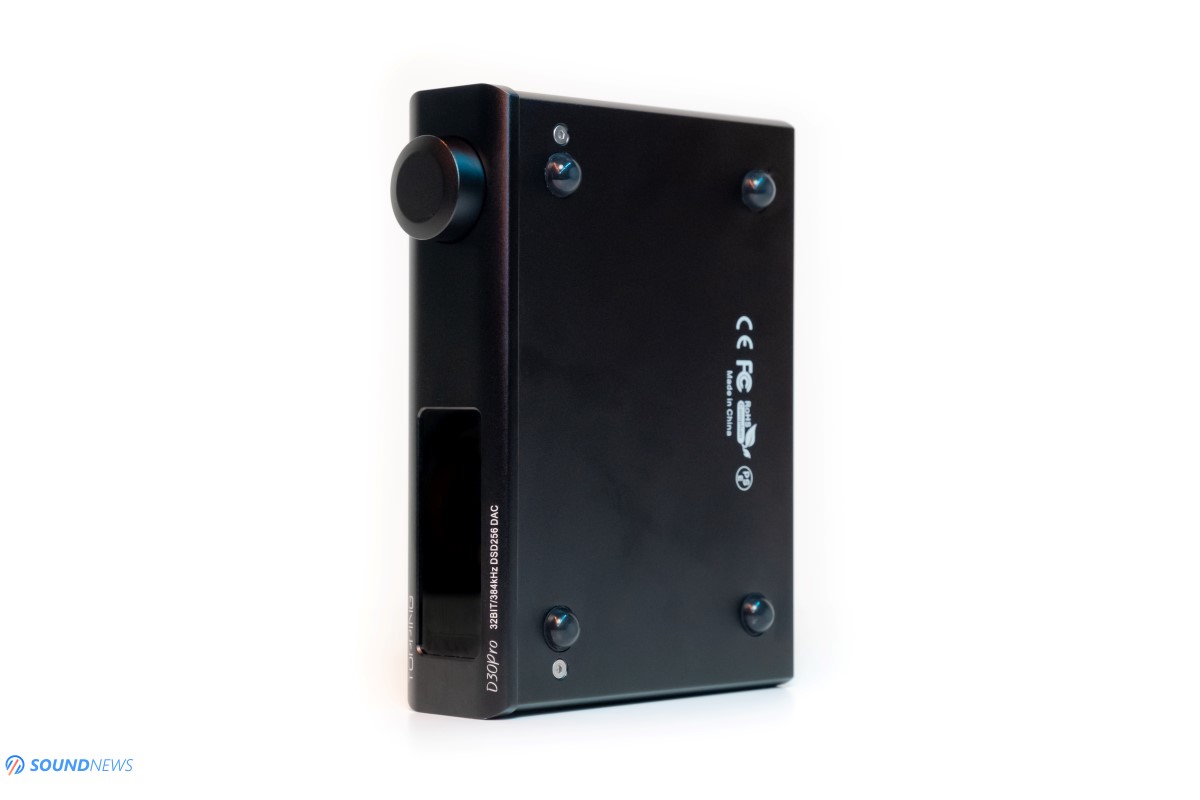
Tech Inside D30 PRO
The coolest part about it is that Topping went with brand new DAC chips of Cirrus Logic, more exactly with a 2-channel (stereo) silicon that is CS43198. For a fully balanced signal, two stereo chips will be needed, meaning that in practice Topping could use two chips for their D30 PRO. As with all DAC chips, they work even better, unleashing a higher dynamic range and a lower noise floor if you use them in mono mode or in parallel. For that you will need at least four DAC chips and this is exactly what Topping did and that is the sole reason why I find it so cool and interesting. It’s the first quad-DAC unit Topping ever did.
As usual with nicer Topping units, you’ll find an Altera FPGA infused with Topping own code that will do all the clock management, PLL shaping and DOP modulation. The good old XMOS XU-208 is used for its USB input, that chipset already supports the highest sample rates, unlocking the true potential of its USB input, supporting up to 32-bit 384 kHz PCM and up to DSD256 natively.
They also used 8 Low-dropout regulators (voltage regulators) in the most crucial parts of the power supply, further lowering its noise floor to inaudible levels. With just 0.9 microVolts (uV) of noise on its RCA out and 1.1uV on its XLR out, you can use it even with ultra-sensitive preamplifiers and power amplifiers without hearing a buzz or hiss.
The only thing I dislike about it, but that’s mostly nitpicking from my part is that it offers the industry standard 4V on its XLR output and not a hotter signal of 5V as they did on D70S. Most power amplifiers are liking a hotter signal coming from a preamp and if you are not willing to buy a separate preamplifier (like their PRE90), a 5V output would work nicer, directly driving a power amplifier.
Topping is not specifying what op-amps are being used at the output stage, but I can only presume that they went to OPA’s from Texas Instruments. You won’t find a Bluetooth antenna, nor MQA capabilities and that is perfectly fine. If you’re hunting for a standalone DAC, you don’t need any of that to enjoy it to the maximum.

Test Equipment
I’ve tested it in a high-end loudspeaker setup and also in several headphone setups. When I used it in the living room, I’ve tried it as a DAC + Pre unit and then only as a DAC, leaving the preamp duties to the Topping PRE90 or to a Benchmark HPA4. I’ve used a Keces S300 power amplifier, that was driving a pair of KEF Reference 3.
In the headphone setup, it was mostly connected to a Benchmark HPA4 or to its soul mate: A30 PRO balanced headphone amp, driving several high-end planar-magnetic and a bunch of dynamic headphones. Okay folks, enough with the talk, my ears are itching for some music, so let’s hit some ear-drums!
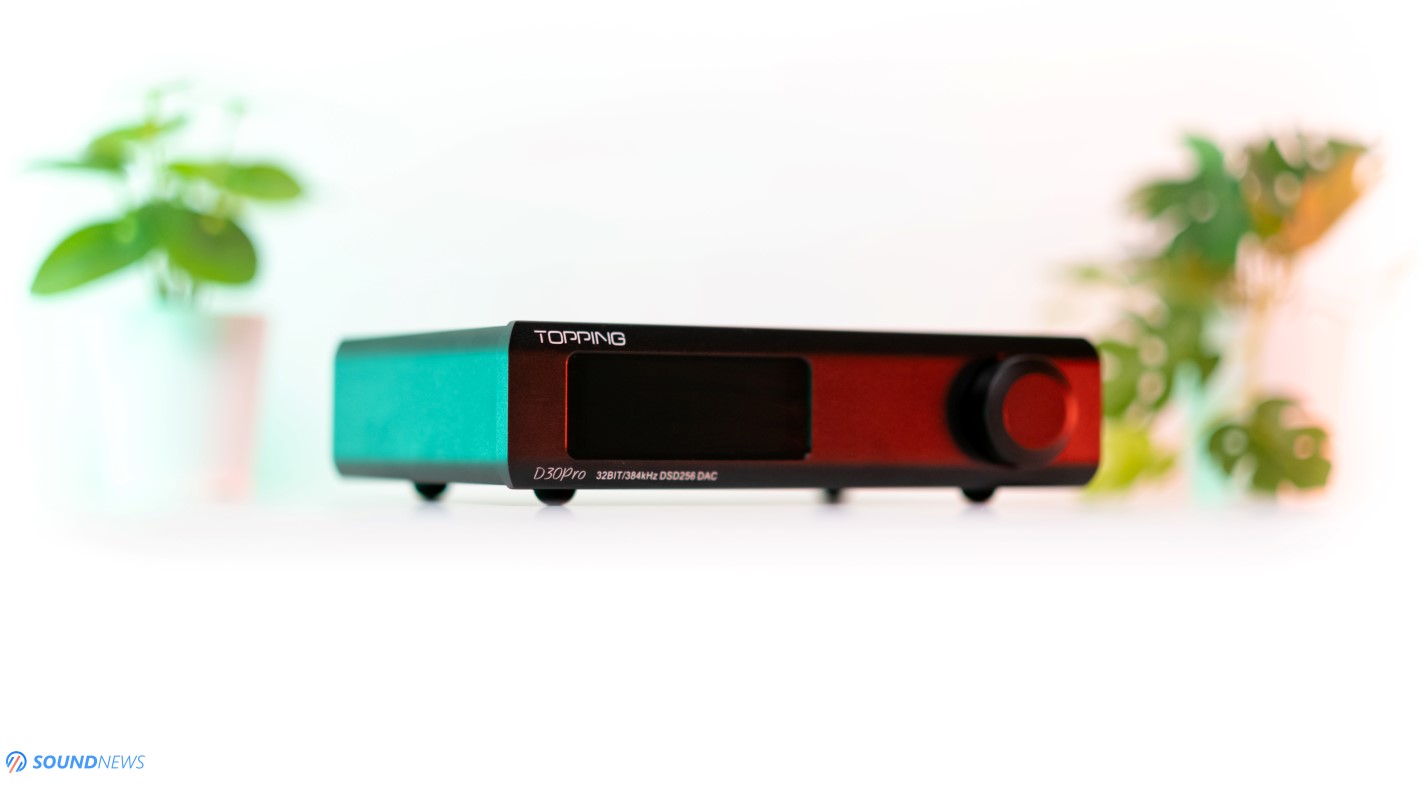
Sound Performance
I. Preliminary Impressions
Ah! The unmistakable Cirrus Logic sound! I’ve immediately remembered some older Headroom DACs (still miss you Tyll) that had the same refinement and velvety textures, I’ve remembered my former EMU card, my iPod Classic that powered some Ultimate Ears Triple-Fi IEMs, I’ve also remembered some high-end units from Marantz (6003, 6006, 7003, 8005 and HD-DAC1 are coming to mind) and in some ways D30 PRO feels like an extension to that sound. Not only you’ll find a calmer transient response that leads to a more peaceful, mid-centric sound, that highlights emotions and smoothness, that improves vocal performance, adds a heavier tone and nuance to musical instruments. But, for the first time ever, I’m hearing a much better detail retrieval, a more extended frequency response, there is a lot more stuff happening around me, a lot more sounds to discover compared to those older devices. Transparency and depth improved tenfold, as I can now look much deeper and easier into my tracks, scanning them for anomalies, for gremlins or for anything really.
I’m very glad that a heavier timbre is present in here, without hurting the air that is traveling around. With Marantz HD-DAC1 I’ve always felt that there isn’t enough air in my room, due to its dense bass and midrange that rolled-off the upper treble, wiping clean parts of the frequency response that led to a somewhat warm and fun listening experience, never delivering the full package. D30 PRO isn’t that dense and full-bodied sounding, its treble is a lot more defined compared to Marantz. I found emotions coming in right doses, but more important than ever, finally there is some air traveling around that could make even AKM-devices envy. The frequency response feels a lot more extended, a lot more complete, delivering the full package to the listener. The older Cirrus Logic sound was all about emotions and less so about technicalities, but their newest silicon combined with the knowledge of Topping, nicely blended all that in a single attractive package that is D30 PRO.
There is just one thing that might not be to everyone’s liking and that is a somewhat limited transient response, not when it comes to speed, but mostly when it comes to impact. D30 PRO doesn’t have a huge capacitance, it can’t store a higher current and unleash it in busy passages. That can be a huge plus for people that enjoy a relaxed easy going sound, but for others like myself that want everything on a plate, including heavy bass slams, that might come as a con. Nonetheless, its weaker transient response can be solved with a better preamp (PRE90 is a very good option), or with a punchier sounding amplifier, be it an integrated, a power or a headphone amplifier.

II. Noise Floor
Most high-end DAC manufacturers are putting a huge accent on their power supplies, as noise floor directly influences the final outcome, the dynamic range and of course its detail retrieval. While Topping isn’t using a high-end toroidal transformer and some fancy capacitors, they already know their stuff and I’m sure that those 8 voltage regulators gave a huge helping hand, leading to an excellent noise rejection. The numbers are speaking for themselves, as at about 1 microVolt of noise, I don’t think you’ll ever hear voices from beyond in your loudspeaker or headphone setup. I’ve went full power on my amplifier, just to discover the peaceful sound of silence with my headphones. Putting it in my loudspeaker setup without a preamplifier in the chain, driving directly a KECES S300 power amplifier didn’t add a drop of hiss or noise into the mix. Gremlins weren’t playing in the background at higher volumes and all I’ve heard was a dead-silent performance with the KEF UNI-Q drivers.
I can understand how a high-end DAC is rejecting all that noise, as when I’ll pop its hood, all that filtering stage will be sitting in front of me, but I can only partially understand how Topping did it with their D30 PRO. I can only presume that there is some sort of mumbo-jumbo applied to its FPGA Altera chip, that is lowering the noise and harmonic distortions to inaudible levels. Hats Off Topping, this is one hell of a clean sounding DAC!

III. Transient Response
As I’ve mentioned before, this chapter alone is less impressive, as it can’t move absurd quantities of air down low and while I’m hearing a close to perfect bass performance, I’m not feeling those notes hitting me relentlessly as a hammer as they do with my reference DACs. There is something stopping it from delivering harder slams in the chest and that can be felt with a loudspeaker and with a headphone setup as well. Luckily, their A30 PRO is an extremely nimble, agile and hard puncher, seriously improving the lighter-weight nature of D30 PRO. If you intend on using it in a loudspeaker setup, please don’t go with a Class-D amplifier, as the final result can be too soft and gentle. All other smaller sized DACs that I’ve tested in the past, performed pretty much the same. Be it Topping D50S, SMSL SU-9 or Gustard X-16, they all had a softer impact and lighter kick, mostly because their output stages weren’t that strong and their capacitance wasn’t that high. I’m sorry, but you can’t have them all especially at this size and price point. If you need Mjolnir’s chest pounding impact, try a higher tiered DAC or use a nicer pre or power amplifier.
In spite of everything, I was pleased to find a faster tempo on D30 PRO compared to all other Cirrus Logic equipped devices I’ve tried in the past. Electro music sounded snappy and nimble, it wasn’t skipping beats, always running besides me even when some lighting fast notes and double drums made an appearance on my playlist. KEF Reference 3 metallic drivers are extremely fast sounding, I’ve always adored them for that and when I’ve placed the little fellow above a power amplifier, it didn’t kill dynamics at all. Reference 3 were still pressing the gas pedal to the floor and I was still smiling all along. Not everything is lost, there is still plenty of life to be found in the little D30 PRO.
The biggest surprise came when I’ve connected a Topping PRE90 and left the D30 PRO in its DAC mode. The sky cracked in half and lightning storms appeared in my room, Thor itself visited my cozy listening place, as finally I’ve experienced bass quality and all the quantity I’ve wanted, slamming and pounding with a much higher force. Obviously, in a less demanding stereo setup the difference with or without a preamp might be much smaller, as it depends a lot on the sensitivity of your loudspeakers and on your amplifier. D30 PRO with PRE90 in the chain sounded like it had a severe case of Polyochidism, smelling bad attitude and testosterone from afar.

IV. Soundstage & Depth
D30 PRO might be lacking a powerful output stage and an overkill capacitance, but I am sure that it isn’t lacking in terms of scale, air around the notes or transparency with some finer jazz recordings. A quad-mono DAC with four DAC chips inside will be squeezing the highest dynamic range, but more importantly it would be seriously improving the channel separation and that is your biggest ally if you want a bigger than life soundstage in your room.
Its RCA output is offering a channel crosstalk of -116 dB, but on its XLR output that number drops to Mariana Trench levels at -145 dB! That is world class performance right here, only some of the best units are having it that low. If all this sounds like some gibberish nonsense, for a bigger scale, for a nicer depth and for a wider stage you want that channel crosstalk as low as possible. The little D30 PRO lacked a bit in the previous chapter, but it transformed in a huge sounding unit, sounding grand, enveloping my entire body all the time. In my humble opinion, this is exactly where it will be outperforming entry to mid-level ESS Sabre equipped converters, even the Gustard X16 didn’t sound as big and imposing as D30 PRO did in my living room.
When Mongol warriors of The HU made an appearance on my playlist, I knew that I’ll be getting chills and goose bumps all over my body. The Great Chinggis Khaan (Qobuz / Tidal) always sounded bigger than life in a loudspeaker setup and that certainly happened with D30 PRO, but to a smaller degree compared to the best units I’ve tried so far. Steppe winds wrapped my entire body and I’ve felt bombarded with tens of sound coming from an invisible canvas that stood before me. The whole experience wasn’t 100% effortless, as sometimes it felt bi-dimensional, certainly not as holographic as I am used to on higher priced converters. Nonetheless, the throat singing of Tengri sons sounded impressive, vibrating and decaying naturally, improving the layering, the immersion and the holography.
I want to be clear that it might sound a little soft and gentle, but it will be increasing and decreasing the stage size, depending on the recording and on the gear that will follow very easily. Sometimes it sounded big and airy and sometimes it felt cozy, close and personal, it surely knows how to increase or decrease the stage size.

V. Resolution & Transparency
There are several converters that are putting micro-details before anything else, Gustard X16, Topping D50S and SMSL SU-9 are very good examples. They will impress you right away with their honesty, with their strong leading edges and defined contours. In time, such kind of performance might tire you down, that will happen more often in a headphone setup as all that unfiltered energy goes directly into your ear canal. Some people like that kind of transparency and detailed presentation, some are wanting a more relaxed presentation that doesn’t want to steal your attention every minute or so. I think that D30 PRO is that kind of converter, that is slowing down a bit, so you can look at the scenery, experiencing the music with a brighter color palette and with a higher euphony. D30 PRO will never point you towards the tiniest details, those were never sharp or overly contoured as they happen to be on ESS-Sabre DACs. Even so, D30 PRO felt as a detailed and transparent sounding unit, but you’ll be the judge if you want to look and hear all the tiniest details, or you can skip them all, relaxing your body and mind, moving your attention to the big picture. There is still a little bit of that delta-sigma oversampling that makes your music cleaner sounding to the real life, but it isn’t that bad and obvious as it happens with entry level converters.
I almost wanted to call it a forgiving sounding unit, mostly because it lacks that fake treble ringing, that can destroy your rock music collection. D30 PRO wasn’t adding brightness, sharpness or a higher presence in the upper treble and that I liked the most about it. You get details, transparency, a heavier tonality, but you never get nasty brightness.

VI. Frequency Response
I’ve moved back listening to high-end headphones that are capable of revealing a little bit more compared to my loudspeaker setup. If you are wondering, Hifiman HE1000SE were my weapons of choice.
A. Bass
It was clear even from the start that D30 PRO possesses a highly engaging and toe tapping bass performance. It is linear and straight for the most part, but its playful and always grabs your attention. It easily reached 20 Hz notes and was able to sustain them if the track asked for it. There was nuance, there was texture, a good layering and a higher pressure in the sub-bass. I wouldn’t call it overdone, but neutral with a warm-ish tint, coming in exact doses, rising my dopamine levels only with some particular tracks. I felt it clean and detailed, it was highly transparent, I never felt it muddy or distorted. I’ve received all the bass quantity I’ve wanted, revealing itself as high-quality type of bass. I strongly believe its bass and midrange sections are a little more interesting and catchier compared to the top-end. Mid-bass feels pretty much the same, it isn’t louder sounding and never felt elevated, but it’s asking for my attention more often. HE1000SE revealed all those low-intensity notes while preserving a faster tempo. The only downside of the little D30 PRO is that it felt a little softer when delivering bass notes. It wasn’t as visceral and hard slamming as I wished for.
B. Midrange
D30 PRO is probably the most impressive in here. Its softness and velvety texture paid off big time and everything located in the midrange region, felt a little more real and more natural. Voices whispered directly into my brain, soprano voices, violins and acoustic guitars were grabbing my soul, infusing more positive emotions, making my day a brighter one. It does resemble AKM-based DACs and well-made R2R designs by a little. It was never thin or lifeless, that never happened even with a drier sounding HE1000SE and in all seriousness, D30 PRO together with A30 PRO are working exceptionally well with brighter and dryer sounding headphones. If you love Hifiman sound, you got to try the little Topping combo that added a higher midrange presence, making them smoother and more enjoyable in long listening sessions. The mid-section felt more defined to everything else, it was meatier and denser sounding. A very positive change with some particular headphones and loudspeakers.
C. Treble
D30 PRO is having a very good treble extension, a lot of presence, detail and shimmering. This is the only range that is never asking for your attention. It isn’t overdone, or elevated, you’ll never find an unnatural excessive ringing or a higher distortion in here. It decays gently and slowly and that creates a sensation of a smoother, more relaxed treble presentation. Its texture feels real and palpable, everything about it reminds about my older Marantz gear. It sounds just right, as opposed to Gustard X16 that was metallic and a little bright with several recordings. The softness moved to the treble region as well, so snare drum hits weren’t raw and unpolished, cymbals lowered their intensity too, like the drummers weren’t merciless with their drum kits anymore.
Overall, its frequency response felt extended and complete, without any rises or drops, but you’ll certainly get attracted a bit more to its mid-bass and midrange sections.
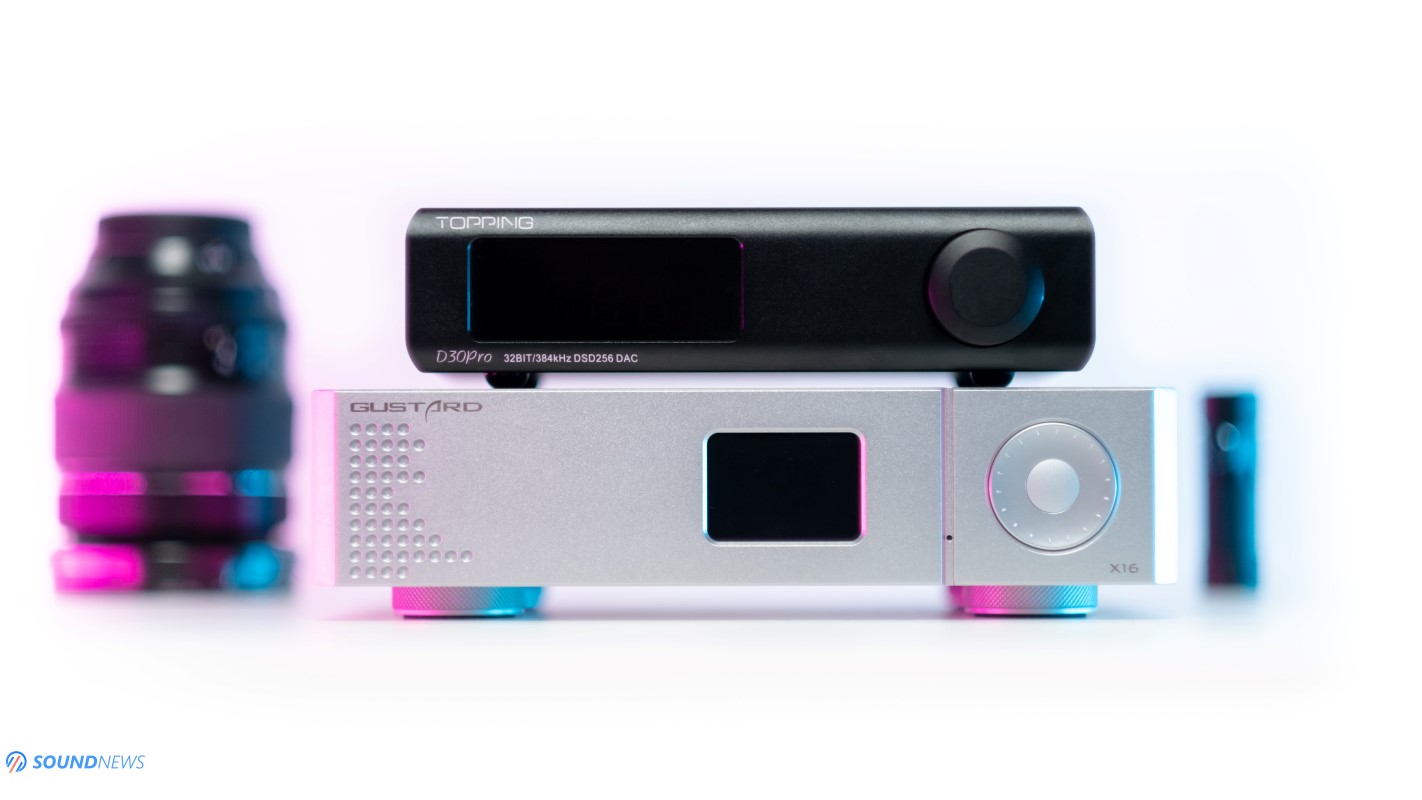
VII. A Comparison
Topping D30 PRO ($399) VS Gustard X16 ($499)
D30 PRO is smaller, lighter, it has a bigger screen and lettering and that might come handy in a loudspeaker setup. X16 on the other hand feels much sturdier, it has a thicker case, a nicer metal feet and a more user-friendly interface. X16 is better when it comes to connectivity as you get an AES, I2S and Bluetooth connectivity which are definitely big pluses. X16 comes also with an MQA decoder if that is important to you.
Both are hiding the screws for a simple and elegant look. both are having remotes and pretty much the same accessories. X16 uses two of the newest ES9068 DAC chips, while D3 PRO uses four CS43198 that are working in parallel. The rest of the specs are slightly better on X16, since it uses some nicer crystal clocks, a better power supply and a higher capacitance.
Since both units are outputting exactly 4V on XLR, I didn’t need to volume match them, since MiniDSP EARS recorded the same sound pressure level (SPL). For this comparison I’ve used Hifiman HE1000SE headphones for the most part and for about 2 hours I’ve moved to the KEF Reference 3 that are better at showing the soundstage and depth.
Before I move to my actual comparison, I’ll just remind you that subjectively I didn’t enjoy much the sound of X16, due to its higher treble itch and to its bi-dimensional soundstage. Sound wise, I wasn’t surprised hearing a nicer midrange delivery on D30 PRO, a nicer mid-bass texture, everything felt by a notch livelier and more engaging. X16 sounded flatter and less emotional, too robotic and too right at times. With X16, its detail retrieval and transparency came first, impressing with its technicalities and very little when it comes to sending shivers through your spine. The higher treble itch on X16 wasn’t beneficial to Reference 3 or to HE1000SE, hence liking the D30 PRO that was gentler and smoother in the upper treble.
The aftershock came a little later when I switched to Hi-Res reference recordings where D30 PRO was portraying a bigger picture, a nicer depth and a wider soundstage, while X16 sounded shier and less impressive in here. After a little more digging, I found the culprit: X16 has a channel separation of 130 dB, while D30 PRO seems much better with 145 dB. In my loudspeaker setup, that was too obvious, Richter, Vivaldi and Mozart sounded grand, effortless and enveloping, all the sounds were distinct from one another, they sat in bigger air bubbles. X16 sounded almost flat, positioning everything to my left or to my right, the air didn’t move as freely and I didn’t encounter notes hitting me from different angles. Spec and measurement wise, X16 may be a little bit more impressive, but my ears are telling me something else entirely. On a very serious note, D30 PRO was making music, speaking directly to my soul, while X16 was making sounds, without moving my body.
The slight softness of D30 PRO wasn’t an issue anymore, because everything else was a lot more important. I’ve remembered again that textured and highly engaging Marantz sound with D30 PRO, versus a colorless and motionless sound of X16. If transparency and a higher detailed retrieval is everything that matters, then X16 seems like a better deal and if you want a bigger scale, a nicer depth, more meat to the bone, a heavier timbre and a more humane rendition of all your music, then D30 PRO looks like a much better deal to me. Sometimes, closing your eyes, listening and trusting your instincts is a lot more important than some numbers written on sheet of paper.

Conclusion
D30 PRO didn’t impress with its technicalities that much, it will never show them to you if you don’t want do. D30 PRO will focus your attention on the big picture, always showing the innards of the music, its beautiful texture, voices would appear sweeter, violins would be weeping with more sorrow and guitars will be vibrating a little longer. D30 wasn’t only a transparent sounding unit, but also an emotional digital creature, infusing a little more soul and joy in everything I’ve listened to. Its softer leading edge, makes it a fantastic digital source to be used in long listening sessions and instead of reminding me about oversampling DACs, it reminded more about softer sounding old non-oversampling DACs. It is more or less the same with a modern twist, capable or decoding Hi-Res and DSD material natively. Its soundstaging capabilities are inversely proportional to its size and weight, it sounded big, wide and enveloping and maybe that is his best trait.
Considering its price point, I am overlooking that slight softness and its gentler impact and I’m recommending the little Topping D30 PRO as a serious music making machine. I wanted to offer it our Gold Award, but since I find it limited when it comes to connectivity and features, it will get a Silver Award instead.

It is fully deserved and I am looking forward to their dual AKM and ESS-Sabre designs, or better yet to their Quad-mono designs. I’m hooked to that channel separation! Topping D30 PRO will cost you $399 which I consider a fair price and a very high-value.
Topping D30 PRO was kindly provided by the Apos Audio and it can be purchased from their web-store by following this link. (Apos is offering free shipping in the USA and Canada, free 45-day returns in case you don’t like it and an extra year of warranty).
If you get one, please come back and leave a comment, I’m curious to know how it performs in your headphone or loudspeaker setup! 😉
PROS:
- Sleek looking device, solid build quality
- Wide open sounding, great layering and depth
- Accurate pin-point imaging
- Extended frequency response
- Zero background noise, very clean sounding
- Revealing and detailed sounding, without over-sharpness
- Lacks digital glare and tames brightness
- Full-bodied and rich sounding, warm tonality
- Great speed and a decent slam
- A very good value
CONS:
- Has a softer transient response
- Doesn’t have a very user-friendly interface
- Lacks several digital inputs
ASSOCIATED EQUIPMENT:
- DACs: Topping D30 PRO, Gustard X16, Gustard X26 PRO, Matrix Audio Element X, Audiobyte HydraVox + HydraZap, Gold Note DS10 Plus + PSU10 Evo
- Headphone Amps: Benchmark HPA4, SparkoS Labs Aries, Singxer SA-1, Musician Andromeda, Flux Lab Acoustics FCN-10, SMSL SP400, Burson Soloist 3X, xDuoo XA-10, Gustard H16, Topping A30 PRO & others
- Power Amp: KECES S300
- IEMs: FiiO FD5, FA9, FH7, Meze Rai Penta, Rai Solo, LittleDot Cu KIS &others
- Portable headphones: Sennheiser Momentum 2, Meze 99 Classics
- Full-sized headphones: Hifiman Susvara, Hifiman HE1000SE, Arya, HE400SE, Audeze LCD-4, Erzetich Phobos, Erzetich Mania, Kennerton Wodan, Magni, Gjallarhorn, Vali, M12S, Quad ERA-1, Ollo S4X Reference, HarmonicDyne Zeus & others
- Loudspeakers: KEF Reference 3
- Interconnects: QED Reference (x2), Topping TCX1 (x2)
- Speaker cables: Kimber PR8, Audioquest Type4
- Power Cables: Isotek EVO3 Premier (x3)
- Balanced Isolation Power Conditioners: PLiXiR Elite BAC400







